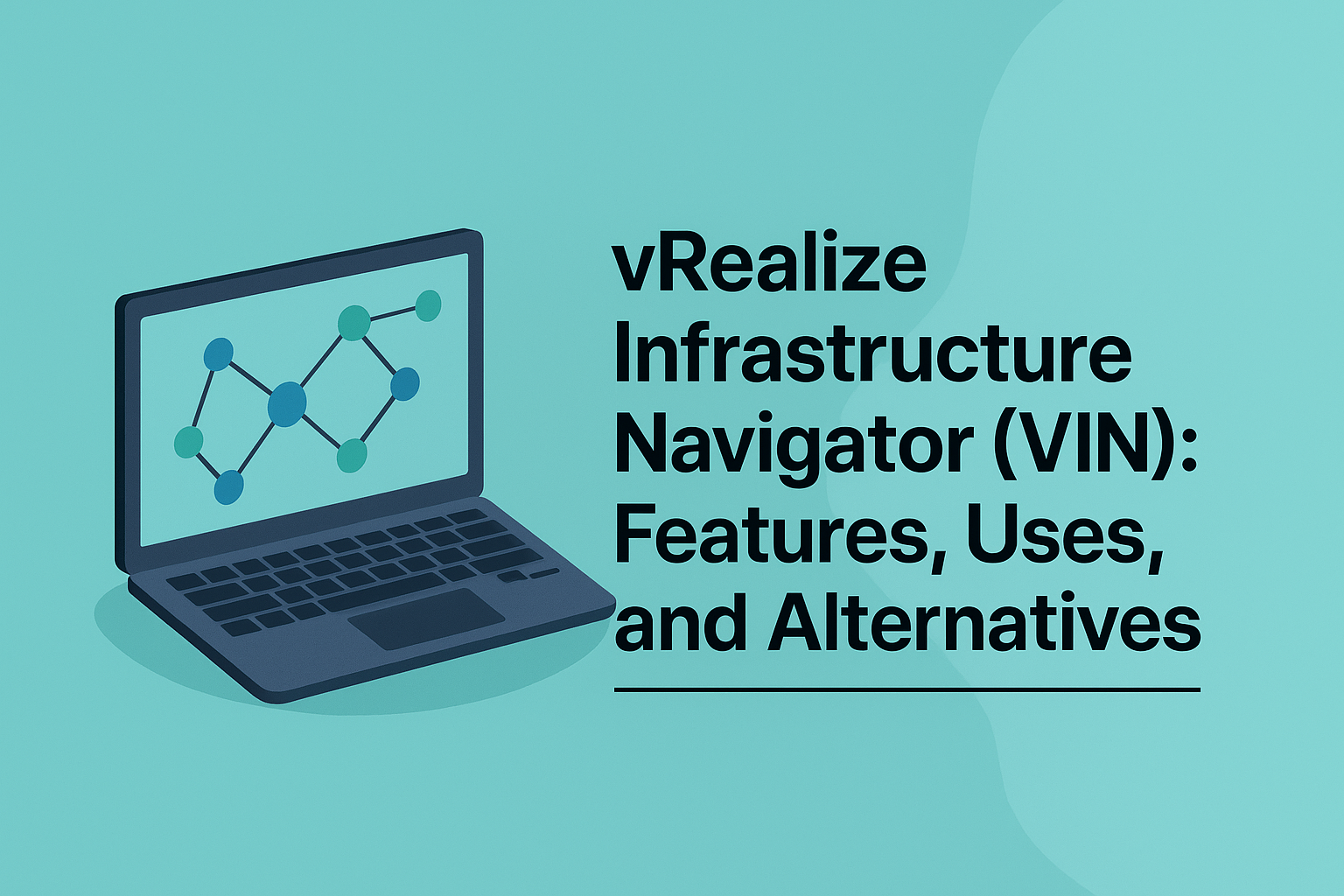Modern business applications are not single servers. They run on many parts like databases, web servers, and middleware. All these parts talk to each other Aiyifan. If one breaks, the whole system may stop working.vrealize infrastructure navigator was a tool that helped IT teams see these hidden connections. VIN could discover and map application dependencies inside VMware vSphere.Even though VMware stopped supporting VIN in 2017, it is still useful to understand what it did and what tools replaced it.
What is vRealize Infrastructure Navigator?
VIN was part of the VMware vRealize Suite. It was a virtual appliance that you deployed in vSphere. Once installed, VIN worked with vCenter Server and showed information in the vSphere Web Client.
VIN helped you:
-
See how applications are connected across virtual machines.
-
Plan changes without breaking critical services.
-
Prepare better for disaster recovery and migrations.
How VIN Worked
VIN collected information using different methods:
-
VM Inspection – looked at settings and behavior of each virtual machine.
-
Guest OS Data – used VMware Tools to read extra info from inside VMs.
-
Network Analysis – tracked communication between VMs.
-
VIX API – pulled data directly from processes inside guest machines.
Main Components
| Component | Purpose |
|---|---|
| VIN Virtual Appliance | Runs the discovery engine |
| vSphere Web Client Plug-in | Shows dependency maps and reports |
| VMware Tools | Collects data from guest operating systems |
| VIX API | Reads process and app-level info from VMs |
| vRealize Operations Manager | Displays VIN data in monitoring dashboards |
Features of VIN
VIN offered some key functions:
-
Automatic Discovery – finds app dependencies without manual setup.
-
Visual Maps – shows application and server links in clear diagrams.
-
Multi-Tier Mapping – supports apps with web, app, and database layers.
-
Context in vSphere – adds app info to VM and host views.
-
Integration with vRealize Operations – connects discovery to performance dashboards.
Why VIN Was Useful
VIN solved problems in many IT situations:
-
Change Management – check which apps are linked before updates.
-
Disaster Recovery – include all related servers in backup plans.
-
Data Center Migration – move all connected systems together.
-
Troubleshooting – trace issues quickly from one VM to another.
Example
| Task | Without VIN | With VIN |
|---|---|---|
| Upgrade a database server | May forget linked apps | Shows all apps depending on the DB |
| Plan disaster recovery | Might miss middleware tier | Maps all layers of the application |
| Fix a web server issue | Guess which DB is impacted | Shows exact database connection |
Deploying vrealize infrastructure navigator
Setup Steps
-
Deploy VIN appliance using OVF template.
-
Add license (usually part of vRealize Suite).
-
Connect VIN to vCenter Server.
-
Ensure VMware Tools is running on VMs.
-
Open required network ports.
Default Security
-
SSH access off by default.
-
Root login disabled (must be enabled manually if needed).
Required Ports
| Port | Use Case |
|---|---|
| 22 | SSH access (disabled by default) |
| 80 | HTTP |
| 443 | Secure vCenter communication |
| 902 | ESXi management |
| 2868 | VIN internal communication |
| 6969 | VIX API guest access |
VIN and vRealize Operations
VIN could connect with vRealize Operations Manager using a management pack. This gave IT teams:
-
Application-aware monitoring – see health of apps, not just VMs.
-
Capacity planning – check if resources fit app needs.
-
Impact analysis – know which apps break if a VM goes down.
Example
| Activity | With vROps Only | With VIN + vROps |
|---|---|---|
| Check CPU spike | Shows only VM impact | Shows app + DB layers linked |
| Plan capacity | Focuses on clusters only | Includes app-level details |
| Monitor SLAs | Limited to infra metrics | Connects metrics to services |
Limitations of vrealize infrastructure navigator
VIN was useful, but had some limits:
-
Worked only in vSphere Web Client (Flash-based, later retired).
-
Scoped to vCenter – no multi-cloud or hybrid support.
-
No deep monitoring – only discovered connections, not full app performance.
-
End of Support in 2017 – no updates or official fixes.
End of Life and Alternatives
VMware ended VIN support in September 2017.
VMware Replacements
-
Service Discovery Management Pack – closest direct replacement.
-
VMware Aria Operations– modern monitoring platform with app context.
-
VMware Aria Operations for Networks – deeper visibility into network flows and hybrid cloud.
Third-Party Tools
-
Dynatrace – advanced AI based monitoring and mapping.
-
AppDynamics – strong application performance monitoring.
-
SolarWinds SAM – broad app and infrastructure monitoring.
| Alternative Tool | Best For |
|---|---|
| Service Discovery Management Pack | Existing vROps customers |
| Aria Operations | VMware-heavy enterprises |
| Aria Operations for Networks | Hybrid and multi-cloud environments |
| Dynatrace / AppDynamics | Enterprises needing deep APM |
| SolarWinds SAM | Hybrid IT with mixed workloads |
FAQ
Q1. What is vRealize Infrastructure Navigator?
VMware vRealize Infrastructure Navigator is a tool that automatically discovers and maps application dependencies in vSphere environments.
Q2. What are the main features of vRealize Infrastructure Navigator?
Key features include automatic application discovery, visual dependency maps, multi-tier mapping, and integration with vRealize Operations Manager.
Q3. Why was vRealize Infrastructure Navigator discontinued?
VMware ended support for VIN in 2017 because it relied on the old vSphere Web Client and lacked support for modern multi-cloud environments.
Q4. What replaced vRealize Infrastructure Navigator?
VIN was replaced by the Service Discovery Management Pack, VMware Aria Operations, and Aria Operations for Networks, which provide stronger monitoring and dependency mapping.
Q5. Is vRealize Infrastructure Navigator still available?
No, VIN is no longer supported or available from VMware. Users should move to modern alternatives like Aria Operations or third-party APM tools.
Q6. What are the best alternatives to vRealize Infrastructure Navigator?
The best alternatives include VMware Aria Operations, Aria Operations for Networks, Dynatrace, AppDynamics, and SolarWinds SAM.
Conclusion
VMware vRealize Infrastructure Navigator was a simple but powerful tool. It helped IT teams:Discover application dependencies.Plan safe upgrades and migrations.Improve disaster recovery strategies.Troubleshoot faster with clear maps.Even though VIN is no longer supported, its role lives on in modern tools like VMware Aria Operations and Aria Operations for Networks, as well as in third-party application performance monitoring platforms.
Application dependency mapping is still critical today, especially with cloud-native apps and hybrid IT environments. The tools have changed, but the need for visibility remains the same.

